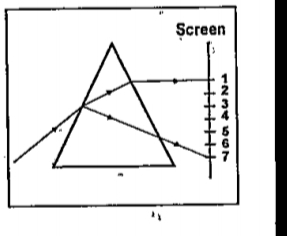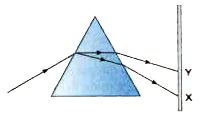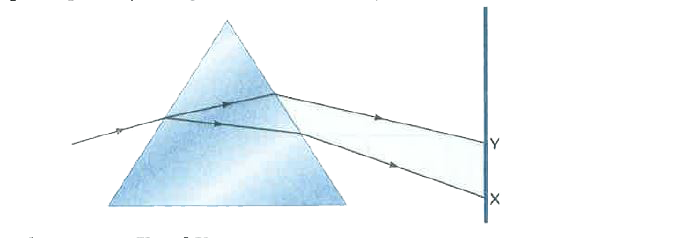A narrow beam of white light passes through a triangular glass
prism and gets split up into seven colours marked 1 to 7.
Which two positions correspond closely to the colour of:
potassium permanganate?
 Solution in Assamese
Solution in Assamese
Step by step video & image solution for A narrow beam of white light passes through a triangular glass prism and gets split up into seven colours marked 1 to 7. Which two positions correspond closely to the colour of: potassium permanganate? by Physics experts to help you in doubts & scoring excellent marks in Class 10 exams.
Updated on:21/07/2023Similar Questions
The splitting of white light into several colours on passing through a glass prism is due to—
View SolutionA narrow beam of white light passes through a triangular glass prism and gets split up into seven colours marked 1 to 7.
Which two positions correspond closely to the colour of:
'danger' or 'stop signal lights'?
View SolutionWhen a beam of white light passes through a triangular glass prism, it splits up into its component colours. It is due to ...........
View SolutionPass sunlight through a triangular shaped glass prism and' it gets split up into component colours. a) What are different component colours? b) Is it the sunlight alone that gets split up into component colours? If not name another light which also gets split up. c) Write the common name of this kind of light.
View SolutionThe splitting up of white light into seven colours on passing through a glass prism is called
View SolutionIn the given figure, a narrow beam of white light is shown to pass through a triangular glass prism. After passing through the prism it produces a spectrum XY on a screen.
(a) State the colour seen at X and Y.
(b) Why do different colours of white light bend through different angles with respect to the incident beam of light?

View SolutionIn the given figure, a narrow beam of white light is shown to pass through a triangular glass prism. After passing through the prism it produces a spectrum XY on a screen.

(a) State the colour seen at X and Y.
(b) Why do different colours of white light bend through different angles with respect to the incident beam of light?
View Solution